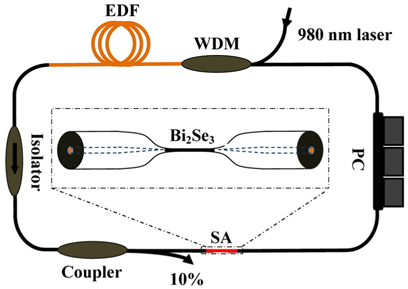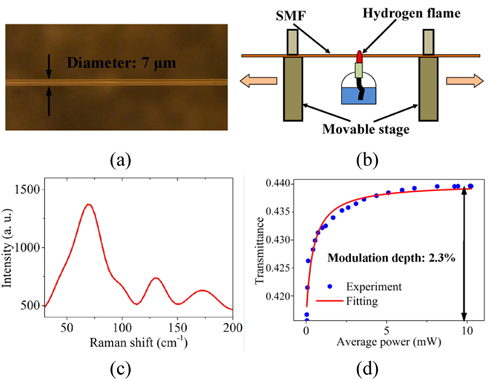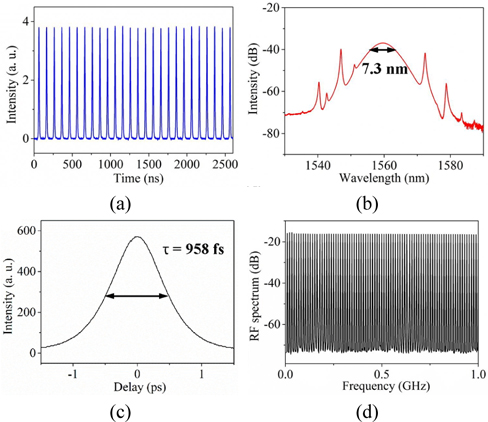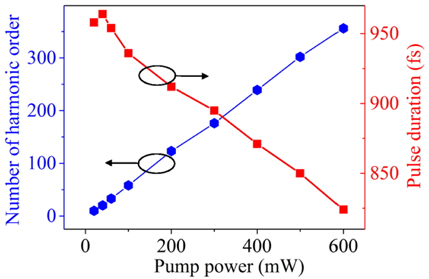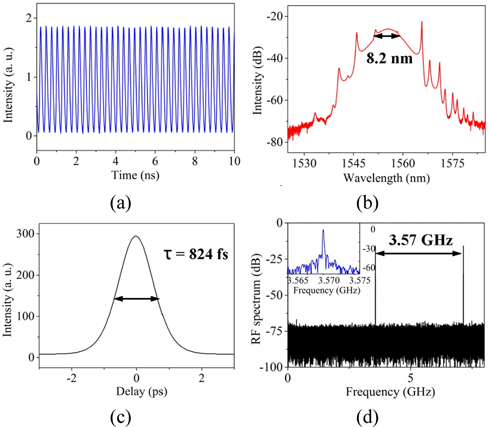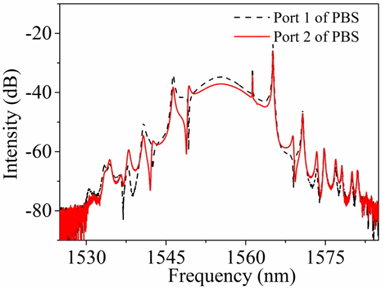



Passively mode-locked fiber (ML) has drawn significant attention for its potential applications in nonlinear optics, micro-machining, communication, sensing, etc. [1-8]. Specifically, ML with sufficient high frequency is a hot topic. This high frequency is possible to achieve via dissipative four-wave-mixing [3-5], or passive harmonic mode-locking (HML) based on high nonlinearity [6-12]. The former technique utilizes an additional optical interferometer with high finesses, such as a Fabry–Pérot interferometer, which increases the cost of the laser system [4]. In contrast, high frequency pulsed laser based on HML is shown to be a potential solution for a low-cost laser system that could be used for a high speed communication, optical microwave source [8]. The physical origin of the HML is that a fundamental soliton laser splits into high order solitons when experiencing significant nonlinear shift, and operation with stable multiple pulses can be maintained when all the effects, such as dispersion, gain and loss, and Kerr effect reach a balance. Nowadays, lots of efforts have been made to generate HML, and several articles have been published. For example, high frequency ML based on nonlinear polarization rotation has been proposed [9]. Also, HML based on nonlinear materials such as graphene and reduced graphene oxide with saturable absorption effect have been reported [10-15]. Those 2-dimensional materials possess excellent saturation absorption advantages due to the unique bandgap structure. Conventionally, the HML is mainly achieved via intense evanescent field, through which pulses accumulate significant nonlinear phase shift due to the strong confinement of light. This phase shift destabilizes the fundamental mode-locking, and leads to break up of those pulses. For example, there are several reports about MLs functioning with HML [6-9]. Recently, new materials, topological insulators (TI), such as, Bi2Se3, Bi2Te3, and Sb2Te3, have shown excellent saturation absorption effect [13-22]. They exhibit a linear dispersion Dirac-like electronic band structure like that of graphene, and saturable absorption is induced by Pauli blocking. Luo
Here, I propose a high frequency mode-locked fiber laser based on Bi2Se3 interacting intensely with a fiber taper. HML is formed when the pump power is larger than 18 mW. I produce the saturable absorber (SA) by depositing Bi2Se3 nanoparticles onto the fiber taper surface with light pressure. I measure the polarization dependent loss of the SA. By incorporating the SA into a fiber ring cavity, stable HML is observed, and the vector nature is experimentally explored with a polarization beam splitter (PBS).
Figure 1 depicts schematically the fiber ring cavity. As shown, it contains 2 m erbium-doped fiber with a peak absorption of 80 dB/m at 1530 nm, and additional 18.4 m SMF. Other devices include a 980 nm laser for pumping the gain fiber, a wavelength division multiplexer (WDM), a polarization independent isolator for unidirectional operation, a polarization controller (PC) for optimizing the polarization state of the cavity, an optical fiber coupler with 10% output, and an SA based on Bi2Se3. The group velocity dispersion of EDF and SMF are 15.7 ps/nm/km and 18 ps/nm/km, respectively, so the net anomalous dispersion is −0.467 ps2. The length of the ring cavity is about 20.4 m, so the fundamental frequency is ~10.03 MHz. The bandwidth of the temporal detecting equipment is 5 GHz (detector: DET08CFC/M, Thorlabs Co., Ltd.; oscilloscope: Pulsecheck, APE) The resolution bandwidth of the radio-frequency (RF) frequency analyzer (Agilent, PSAE4447A) is 1 kHz, and the optical frequency information is analyzed by an optical spectrum analyzer (AQ6370, Yokogawa) with a resolution of 0.05 nm. To investigate the polarization characteristics, I use a fiber-based PBS.
The SA is produced by depositing the Bi2Se3 particles onto the taper with light pressure as in [19]. The fiber taper shown in Fig. 2(a) possesses a waist diameter of 7 μm, and the length of the uniform section is larger than 15 mm. It was produced from a standard single mode fiber (SMF, Corning SMF-28)) with hydrogen flame as shown in Fig. 2(b). Based on a strong evanescent-interaction with Be2Se3, this taper would provide sufficient high nonlinearity for HML. The taper loss is about 0.5 dB at C bands, and no modulation is shown in the transmission spectrum. The Bi2Se3 flakes are produced by exfoliating Bi2Se3 crystal produced from bismuth oxide powder and selenium powder [26], then the crystal is sonicated in N-methy1-2-pyrrolidone solution to get few-layer Bi2Se3 solution. Its corresponding Raman spectrum in Fig. 2(c) contains three typical Raman peaks, A11g, E2g, and A21g, locating at 72 cm−1, 129 cm−1, and 173 cm−1, respectively. I immerse the taper into the Bi2Se3 solution, and inject 10 mW continuous 980 nm laser into one port of the taper and monitor the output power from the other port. 20 seconds later, the deposition loss drops to ~4 dB. I pick up the taper and dry it for further experiment. I measure the polarization dependent losses (PDLs) of the pure taper and the SA at 1560 nm as 0.5 dB and 2.5 dB, respectively. The relative large PDL of the SA is originated because the nanoparticles have not been deposited uniformly on the taper. For example, gravity would make the deposition asymmetric, and the different sizes of the particles may also contribute to the relative PDL. However, the following experiment indicates that although the saturable absorption materials may possess significant PDL, the fiber taper deposition method would be an excellent choice for fabricating SA for vector ML.
I measure the nonlinear transmission of the fabricated SA based on a balance two-detectors method as in Ref. 26. The detailed parameters of the optical source are as follow: center wavelength (1560 nm); pulse duration (540 fs); repetition rate (13 MHz). Figure 2(d) depicts the nonlinear optical response, and the modulation depth is 2.3%.
Due to the stochastic birefringence induced by twisting of the fiber, polarization adjusting with a PC is needed. In our experiment, stable ML with fundamental frequency is observed for pump power larger than 18 mW. This low threshold is mainly induced by relatively small saturation intensity. Figure 3 shows the typical output for pump power at 20 mW. The oscilloscope trace contains a period of 99.7 ns, corresponding to the fundamental frequency of 10.03 MHz. The optical spectrum contains significant Kelly sidebands, and the full width at half maximum (FWHM) of the spectrum is about 7.3 nm. The autocorrelation trace shows a pulse duration of 958 fs. The RF spectrum contains a contrast ratio of 70 dB at the fundamental frequency.
When the pump power is increased, different orders of harmonic mode-locking can be observed. Figure 4 depicts the order of HML with respect to pump power. In our experiment, a maximum order of 356th, namely 3.57 GHz, is obtained, and pump power larger than 600 mW will destroy the SA. The average output power is 11.5 mW for pump power at 600 mW. Figure 5 depicts the typical temporal trains, optical spectra, the single pulse widths, and the RF spectra of this HML. As shown in Fig. 5(a), the pulse train in HML seems broad. This is because that the pulse period is comparable to the bandwidth of the oscilloscope. However, the contrast ratio larger than 60 dB at harmonic fundamental frequency shown in Fig. 5(d) indicates that this HML is also very stable. The FWHM of the total optical spectrum is 8.2 nm, which is slightly larger than that of the fundamental mode-locking. The autocorrelation trace in Fig. 5(c) shows a pulse duration of 824 fs after fitted by sech2 shape. The time-bandwidth product (TBP) of this laser is 0.571, which is larger than the 0.315 for a standard transform limited pulse.
I examine the vector nature of soliton laser with a PBS. Clearly, the system generates pulses within both polarization directions. As shown in Fig. 6, optical spectra in the two ports of the PBS differ from each other, and cross couplings are found at several frequencies. The pulse durations and contrast ratios of the two polarization directions are found to be the same. This may be induced by the relative large resolution of the autocorrelator. In our experiment, all devices are polarization independent, and the PDL of SA is also relative small. This laser cavity always supports two orthogonal polarization modes. The small random birefringence in the cavity can be tuned by the PC, and I observed stable polarization fixed vector laser. I record the output of the two ports of the PBS, and the detected signals keep the same intensities. This result indicates that the vector laser is polarization locked rather than rotated. Generally, harmonic ML and fundamental ML share similar vector characteristics.
I propose a vector harmonic mode-locked fiber laser based on fiber taper interacting strongly with topological insulator Bi2Se3. The strong confinement of fiber taper enhances the nonlinearity of the cavity, and a maximum harmonic mode-locking of 356th is obtained. A pulse train with a duration of 824 fs, and a spectrum width of 8.2 nm is observed. As the particles of topological insulator are deposited uniformly onto the taper surface, the polarization dependent loss is small enough to get a vector functioning state. This kind of vector high frequency pulse laser would find potential applications in nonlinear optics, communication, sensing etc.
